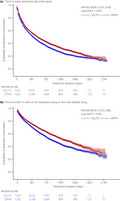- Record: found
- Abstract: found
- Article: found
Cardiometabolic risk reductions in patients with type 2 diabetes mellitus newly treated with a sodium–glucose cotransporter 2 inhibitor versus a dipeptidyl peptidase‐4 inhibitor: A real‐world administrative database study in Japan

Read this article at
Abstract
Aims/Introduction
Sodium–glucose cotransporter 2 inhibitors (SGLT2i) have shown beneficial effects on cardiometabolic risk factors (hemoglobin A1c, body mass index, systolic blood pressure) in patients with type 2 diabetes mellitus. We compared combined cardiometabolic effects of SGLT2i on hemoglobin A1c, body mass index and systolic blood pressure versus dipeptidyl peptidase‐4 inhibitors (DPP4i) in Japanese patients with type 2 diabetes mellitus.
Materials and Methods
This Japanese retrospective cohort study used the JMDC claims database. Patients newly treated with an SGLT2i ( n = 18,936) or DPP4i ( n = 55,484) were enrolled (January 2015–March 2020) and matched 1:1 using the propensity score. The primary end‐point was the proportion of patients achieving a composite outcome (i.e., simultaneous absolute/percent reduction in hemoglobin A1c ≥0.5%, body mass index ≥3% and systolic blood pressure ≥2 mmHg) 1 year after first SGLT2i or DPP4i prescription; Mantel–Haenszel common risk difference and its 95% confidence interval were estimated. Other end‐points included treatment persistence, with the associated hazard ratio calculated using the Cox proportional hazards model.
Results
After matching, patient characteristics were balanced (7,302 patients each). The proportion of patients achieving the composite outcome was significantly greater in patients receiving an SGLT2i than those receiving a DPP4i (31.0% [1,279/4,120] vs 12.9% [524/4,070], risk difference 18.6%, 95% confidence interval 16.3, 20.9, P < 0.001). Risk of treatment discontinuation was significantly lower in the SGLT2i group than in the DPP4i group (hazard ratio 0.85, 95% confidence interval 0.81, 0.90, P < 0.001).
Abstract
In this large retrospective cohort study using a Japanese administrative database, the proportion of patients with type 2 diabetes mellitus achieving a simultaneous improvement in hemoglobin A1c, body mass index and systolic blood pressure was significantly greater in patients newly treated with a sodium–glucose cotransporter 2 inhibitor than those newly treated with a dipeptidyl peptidase‐4 inhibitor. Furthermore, sodium–glucose cotransporter 2 inhibitor treatment showed better treatment persistence than dipeptidyl peptidase‐4 inhibitor treatment.
Related collections
Most cited references33
- Record: found
- Abstract: found
- Article: not found
A new method of classifying prognostic comorbidity in longitudinal studies: Development and validation
- Record: found
- Abstract: found
- Article: not found
Empagliflozin, Cardiovascular Outcomes, and Mortality in Type 2 Diabetes.
- Record: found
- Abstract: found
- Article: not found
